What is the Beta Lab Results?
In order to view the Beta Lab module, users can select the ‘Beta’ option under the ‘Lab Result view’. (Personal > Preferences > General)
Click here to see how.
The user navigates to ‘Lab’ under ‘Orders & Results’ in the ‘Personal’ module. On clicking the ‘Results’ tab, the result listing is displayed in the left pane and the selected lab result is shown in the right pane.
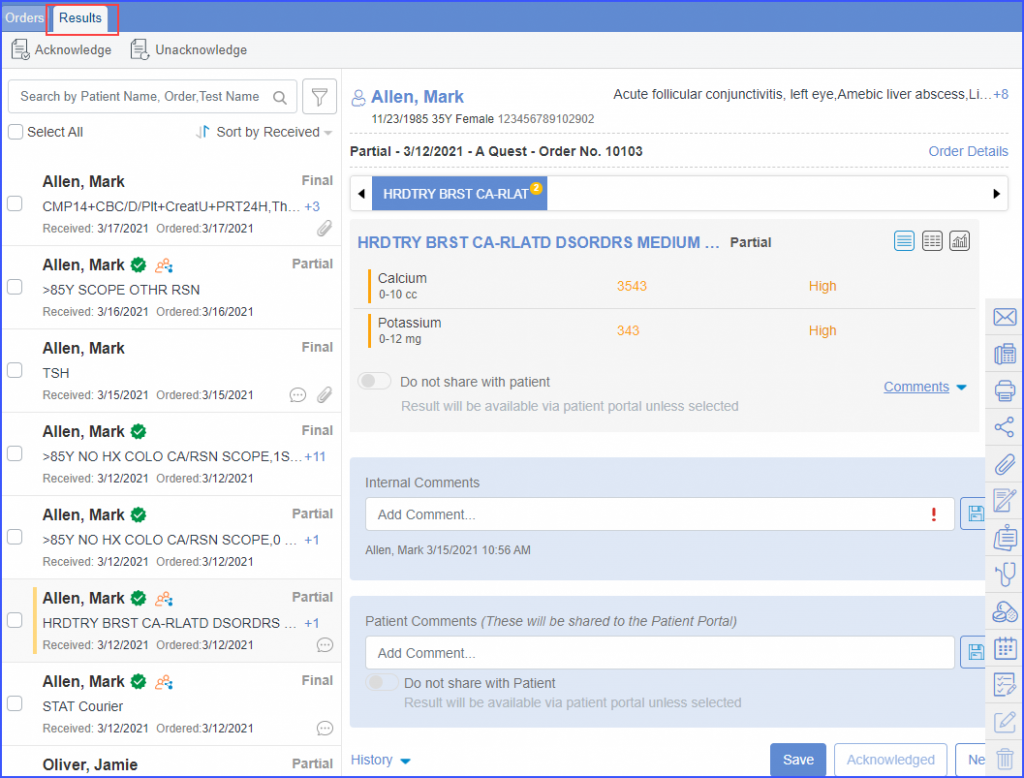
Users can use the Search feature to find lab results by the patient name, order number or test name. Search results are segregated by:
- Patient Name
- Test Name
- Order
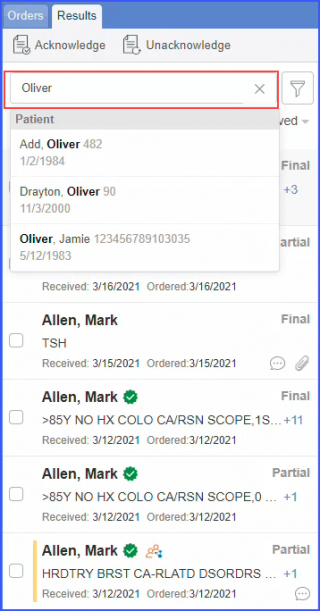
Filters can be applied to refine the search. Provided filters are:
- Normal/Abnormal Results
- Received Date (Today, Last 7/30/365 days, and Date Range)
- Ordered Date (Today, Last 7/30/365 days, and Date Range)
- Assigned To
- Ordering Provider
- Result Status
- Lab
- Patient Location
- Ordering Location
- Retain filters

Filter tags are created for all the filters applied by users. These can be removed easily by either crossing them out or updating them from the filters menu.
The ‘Received in the last 90 days’ filter is applied by default when the user navigates to lab results.![]()
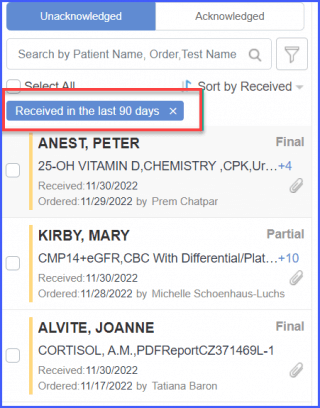
The default filter can be temporarily removed by clicking the cross icon on the filter tag.
If the user applies a different filter and retains it by marking the ‘Retain Filters’ checkbox, the newly applied filter becomes the default.
Results can be sorted by:
- Patient Name
- Ordered Date
- Received Date
- Specimen Date
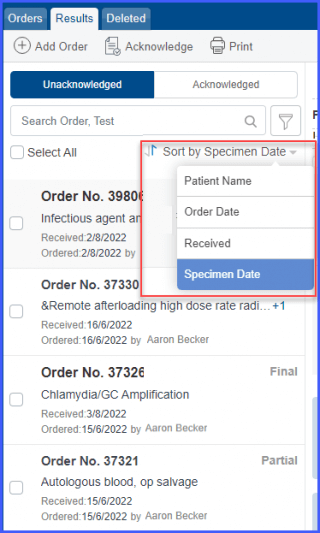
Sorting can be changed to ascending or descending using the ‘![]() ’ icon.
’ icon.

Patient name, test name, received date, ordered date and status of the result are mentioned in the result preview. Any detail that is exceeding the text limit is shown in tooltips. The tooltip also shows the patient’s next appointment date and time.

Moreover, the result preview displays the ordering provider’s name.

Badges appear next to each result to indicate if they are critical/advisory, acknowledged, have additional attachments or comments, assigned to a user and shared to patient portal. The details of the badges are displayed below:
- Shared with the Patient via Portal (
 )
) - Acknowledged (
 )
) - Assigned to user (
 )
) - Attachments (
 )
) - Comments (
 )
)
Critical results are marked by red indicators whereas advisory results are shown with yellow indicators.
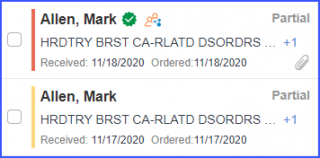
Select a lab result to view its details in the right pane.
The patient’s name, account number, gender and age are displayed in the top right on the patient banner. The current and past diagnosis are also mentioned in this section.
Users can also see the next appointment of the patient in this section.
Order details such as the order number, ordered date, ordering provider, and accession number are also displayed in this section.
The status of the result, received date, and laboratory name are also displayed here.
A tooltip is available on the patient’s name which shows all handy details including patient portal status, ethnicity, race, contact information, PCP etc.
Users can click on the patient name in the patient banner or the listing page to re-navigate to the patient profile.
Status of patient portal is depicted by the following icons:
- Patient not registered on portal (
 )
) - Inactive patient portal (
 )
) - Active patient portal (
 )
)

The navigation bar provides centralized control to go through all tests in the result. Users can click on the ‘![]() ’ icon to view all the tests and jump to the desired test.
’ icon to view all the tests and jump to the desired test.
A count of abnormal observations is displayed on top of the test name in the navigation bar.
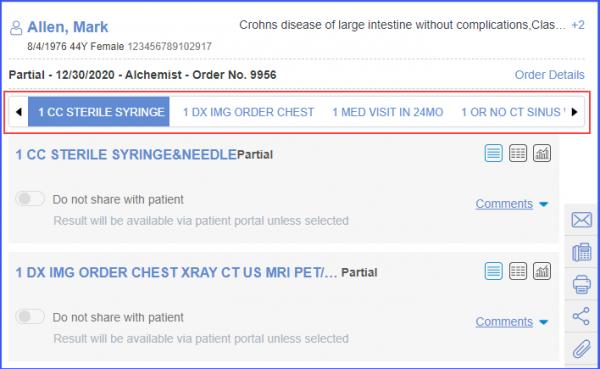
Users can view the result in the following views:
- List View
- Flow sheet
- Graph

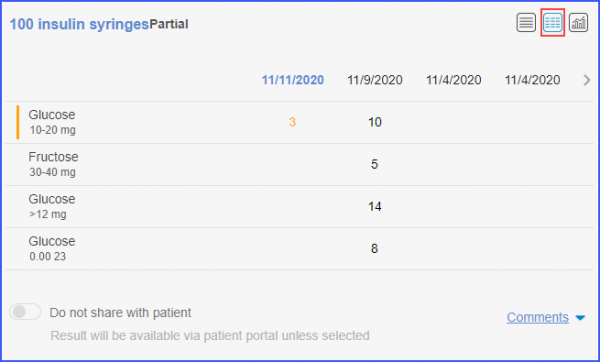
In the graph view, graph is displayed for the selected observation only. Multiple observations cannot be selected at the same time.
To view graph view of the lab result, click the graph view icon.
Date range for the graph can be selected using the ‘Reset’ and ‘To’ text boxes.

Users can zoom in and out of the graph using the ‘ + ‘ and ‘ – ‘ icons respectively.
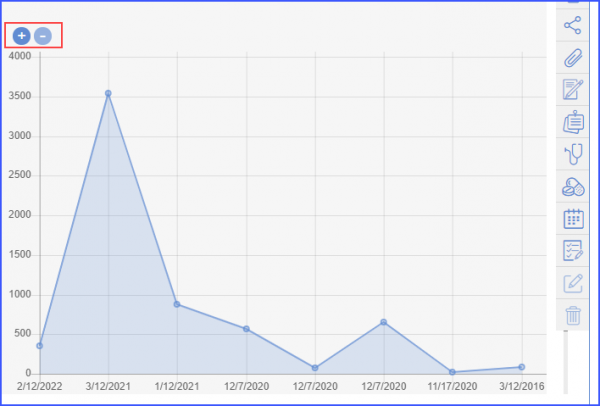
The date ranges on the x-axis of the graph can be displayed in chronological or reverse chronological order. Click here to see how.
Users can view the specimen details related to each test as well. The details include specimen name, received date, ordered date, and ordered by.

An icon to view test instructions has been added in lab results in the beta view.![]()
This allows users to view test instructions sent to the lab with the order.
When the user opens a specific lab result that has test instructions associated with it, the system displays a ‘Test Instructions’ icon next to ‘Specimen’ icon.
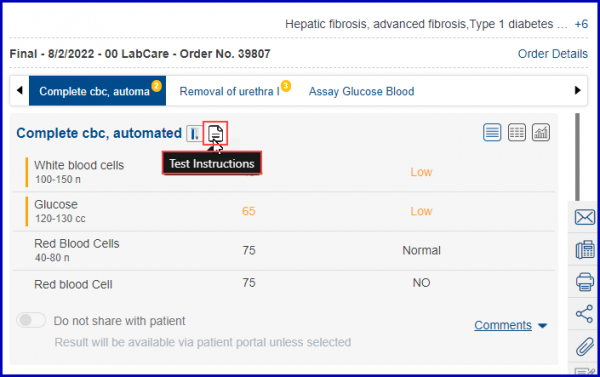
Clicking on this icon opens the test instructions associated with the lab order.

Users can use the floating menu to perform various actions:

On hovering on the floating menu, the following icon details are displayed:
- Fax
- Share
- Attachments
- Assign
- Provider Notes
- Diagnosis
- Medications
- Appointments
- Tasks
- Edit
- Delete
Users can add internal and patient comments on every test. The internal comments can be marked as important using the ‘![]() ’ icon. Comments that are marked important are pinned to the top.
’ icon. Comments that are marked important are pinned to the top.
Sharing for lab results has been made customizable. Sharing of tests can now be managed via toggle button provided. User can choose to share specific tests with patients.
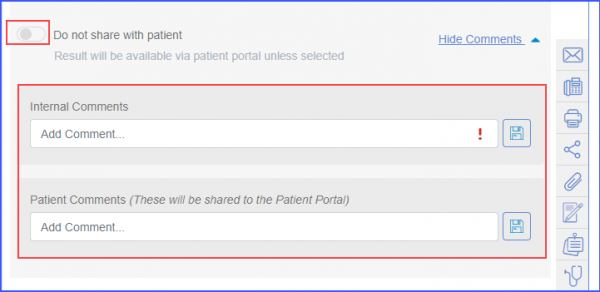
Patient and internal comments are shown on reports and provider note SOAP text based on user preferences.
Internal and patient comments are automatically saved for a result in Beta Labs Module.![]()
This ensures retention of important comments.
If the user adds ‘Internal Comments’ and ‘Patient Comments’ and navigates to perform an action on ‘Diagnosis’ or ‘Appointment’ in the floating menu without clicking on the ‘Save’ buttons next to Internal Comments and Patient Comment, the comments are still saved.
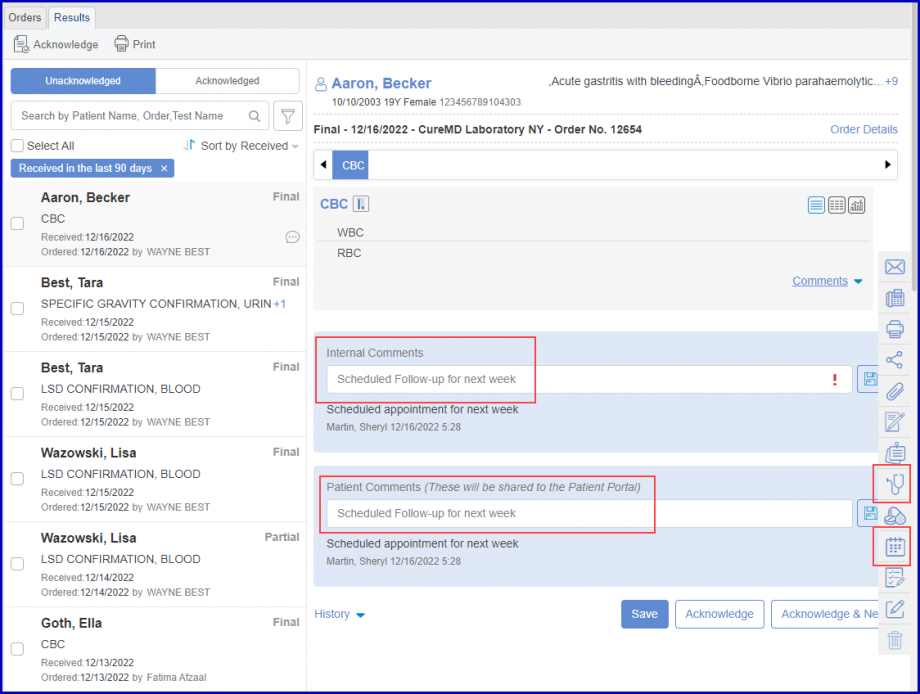
Similarly, the added Internal Comments and Patient Comment are auto saved if user clicks on the ‘Acknowledge’ or ‘Next’ button without clicking on the ‘Save’ button next to Internal Comments and Patient Comment.

However, if the user adds an Internal Comment or a Patient Comment and tries to navigates to the any other action, including ‘Add Order’, ‘Add Result’ , ‘Acknowledge’ or ‘Print’, the system displays a prompt alert stating: ‘The comments added are not saved. Do you still want to proceed?‘
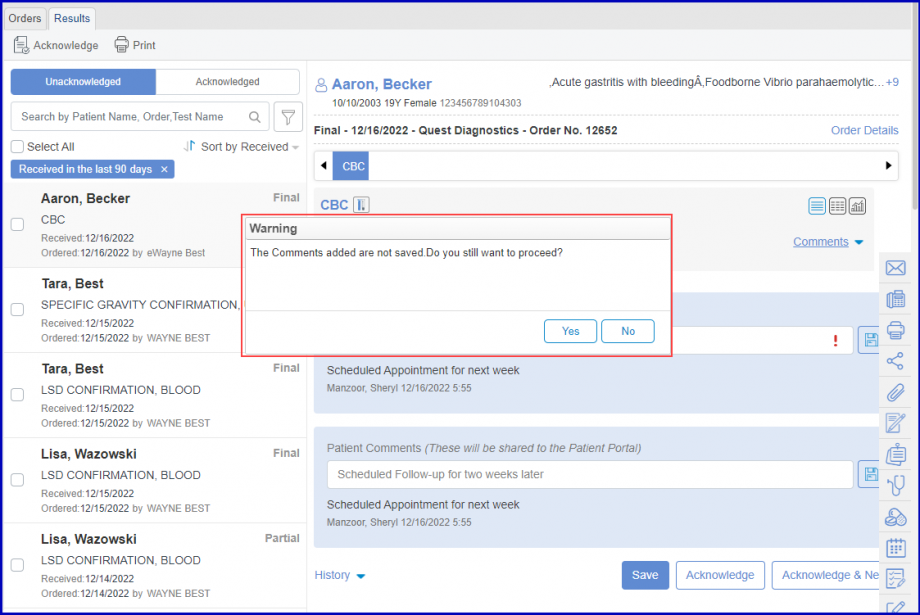
Clicking on the ‘Yes’ button deletes the comments and takes the user to the desired page.
However, clicking on the ‘No’ button allows the user to return to the previous page where comments can be saved.
Action buttons are provided at the bottom of the result.
- Acknowledge: Used to acknowledge the current result
- Save: Used to simultaneously save all comments added at test and result level
- Acknowledge & Next: Used to acknowledge current result and navigate to the next result.
Logs are maintained for all actions performed.

Attachments can be added or deleted from the lab results in beta view.
This provides user the option to remove an incorrect attachment.
In the ‘Results’ tab, click ‘Attachments’ from the floating menu.

System displays an ‘Attachment’ window which has:
- Hyperlinks for attached files
- Download icon

- Delete icon

- Upload button
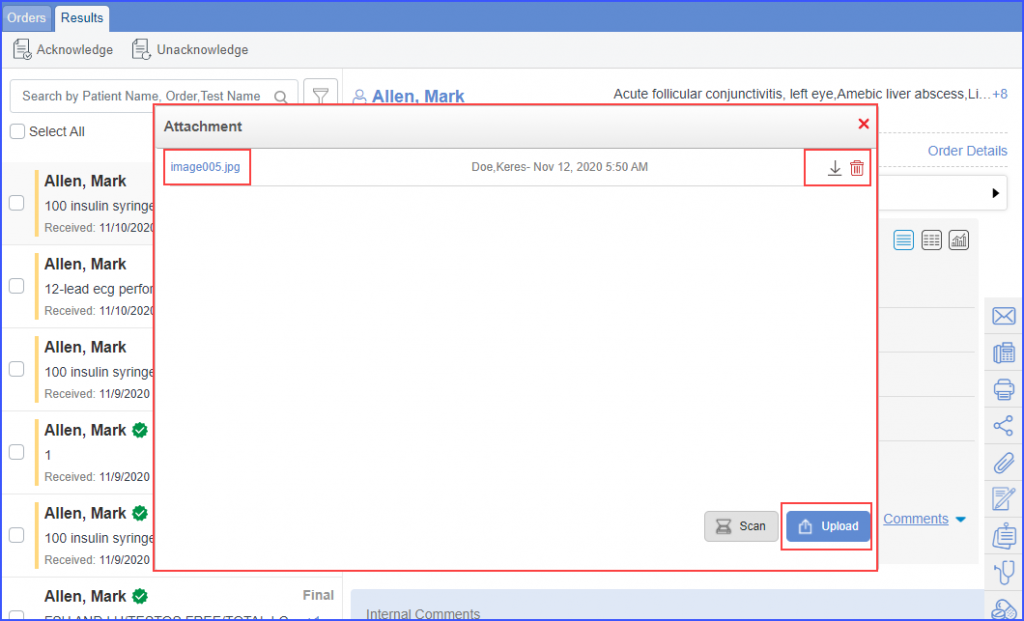
User can view a file by clicking on its hyperlink. In case the file is in unsupported format, it gets downloaded. A file can also be downloaded by clicking the ‘![]() ’ icon.
’ icon.
To remove a file from the attachments, click on the ‘![]() ’ icon. ‘Delete Attachment’ window appears where the user can add a Reason/Comments. Click ‘Yes’ and the file is removed.
’ icon. ‘Delete Attachment’ window appears where the user can add a Reason/Comments. Click ‘Yes’ and the file is removed.

To restore a deleted file, user can navigate to ‘History’ and click ‘Restore’ hyperlink next to the file.

‘Restore Attachment’ window appears where the user should click ‘Yes’ and the file is moved back to the attachments.
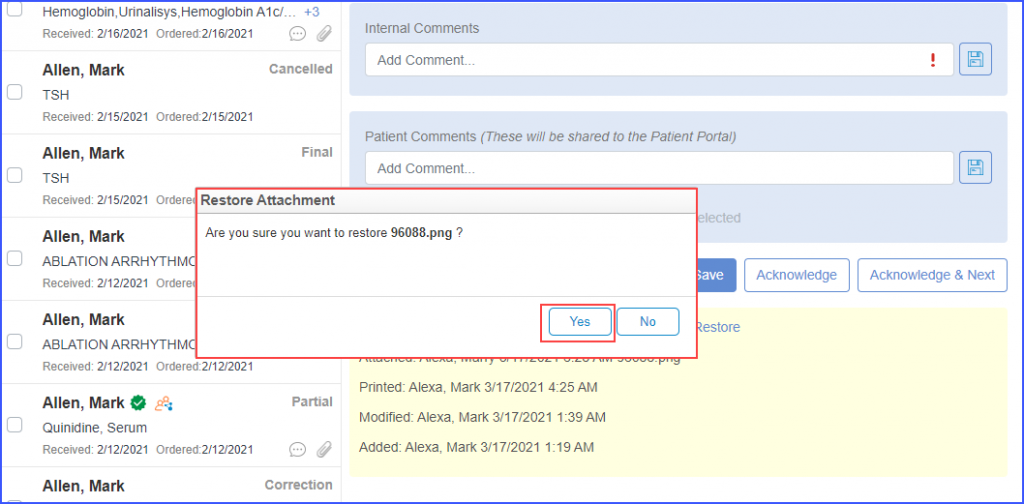
A file can be added to the attachments by clicking the ‘Upload’ button.
If the user permission ‘Edit Lab Result’ is disabled in the ‘Settings’ module, the user can only download a file. ‘Scan’, ‘Upload’, and ‘Delete’ buttons disappear from the ‘Attachment’ window.
In order to enable ‘Edit Lab Result’ click here.
Users can view lab orders which have not been delivered to the labs. Once an order has been placed it is listed in the ‘Orders’ tab.
For each undelivered order an icon appears next to the order number.
The system displays ‘Queued’ ![]() icon for orders which are under processing and ‘Failed to Send’
icon for orders which are under processing and ‘Failed to Send’ ![]() icon for orders which could not be sent due to an error.
icon for orders which could not be sent due to an error.
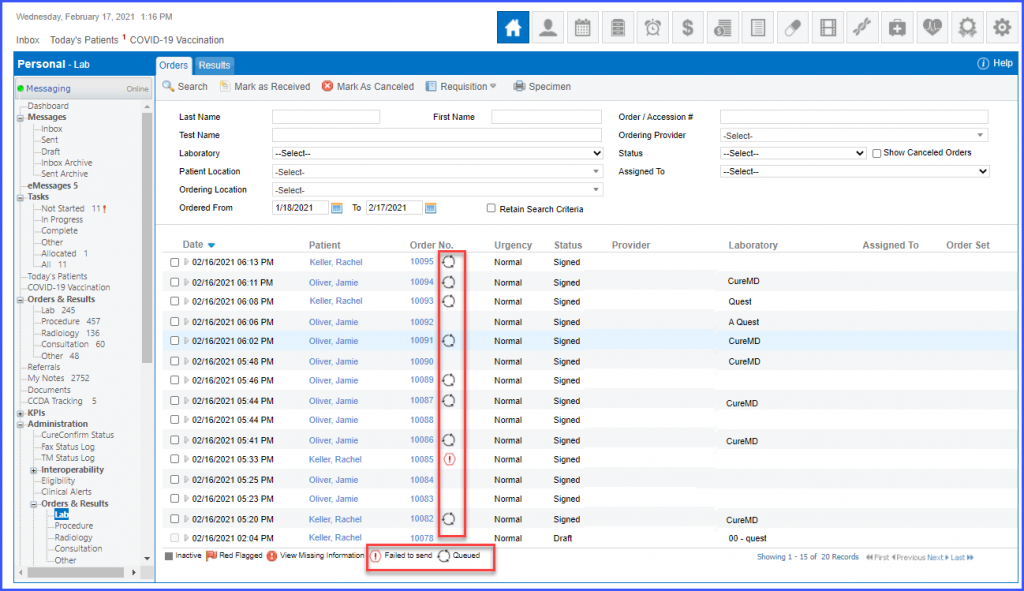
When the user hovers over the ‘Failed to send’ icon the system displays a tooltip ‘This order could not be sent. Please contact practice administrator’.
Similarly, hovering over the ‘Queued’ icon displays a tooltip ‘Queued – Approximate reprocessing time is () min(s)’.
System displays lab results in report view by default. In ‘Report View’, it is easier for the user to view all the important lab result information.
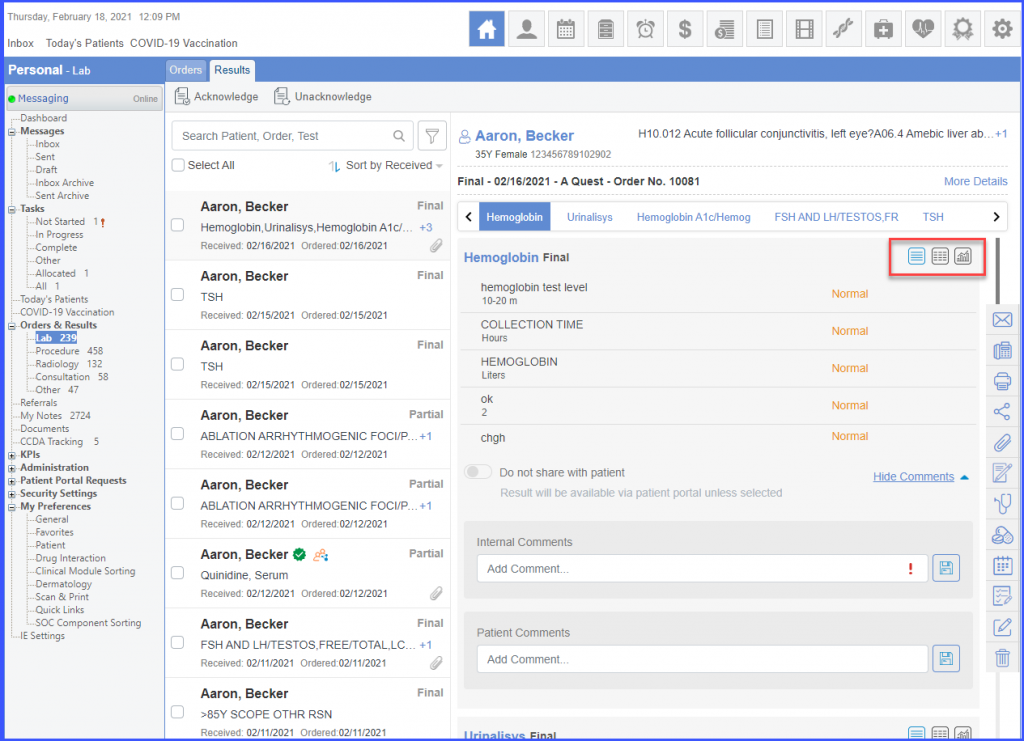
Users can fill-out the HIV Post-test form in the Lab Results.![]()
This allows HIV post-screening information to be collected for better patient care
Click here to see how to enable forms associated with Lab Results via Settings.
Once the HIV screening test result is opened, the system displays an option to fill the post-test form by clicking on the fill form icon.

When the user clicks on the fill form icon, the HIV Post Test Form is displayed.

When the user fills all the mandatory fields and clicks the ‘Submit’ button, the fill form icon disappears from the list of icons. The filled form can be accessed through the ‘Attachments’ icon on the side of the lab results tile.
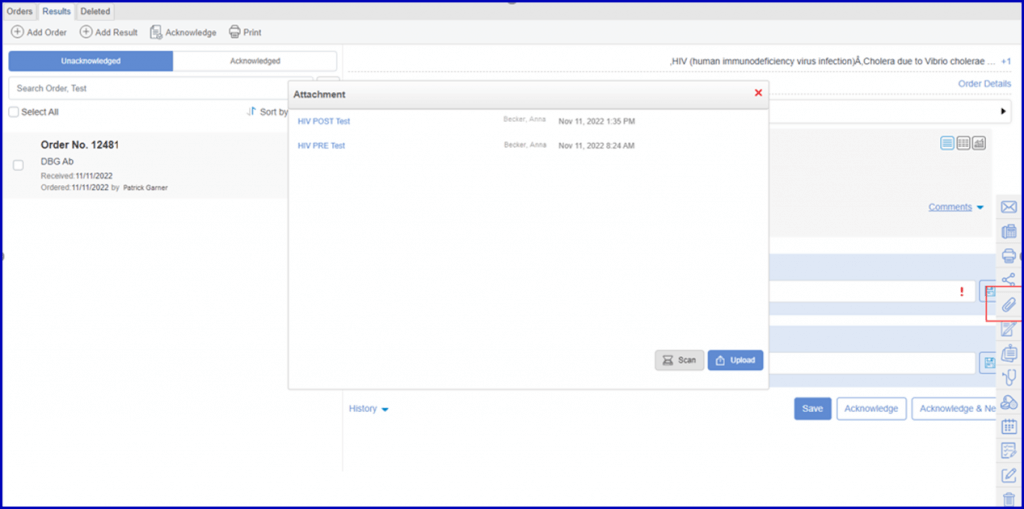
The system logs the entry of the filled form in the ‘History’ dropdown with the ‘Attached’ text.

Users can view provider notes from the lab results.
Click on ‘Provider Notes’ in the floating menu.
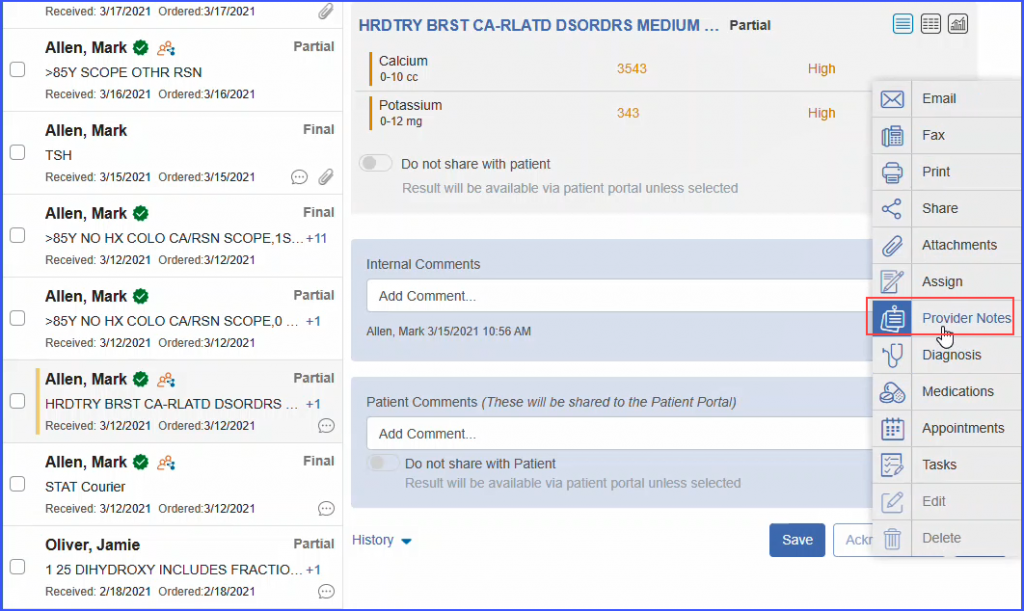
The system displays a ‘Provider Notes’ window with the most recent provider note of the patient.
If there are no provider notes added for the patient then the system displays ‘No provider notes added’.
The user can view all the provider notes of the patient by using the navigation arrows.

Provider notes cannot be edited in ‘Provider Notes’ window.
Unauthorized users can be prevented from viewing provider notes icon in the floating menu. In order to view how to manage permissions, click here.
Users can print multiple lab results simultaneously.
To print the lab results, mark the checkboxes for the desired lab results. Then click ‘Print’.
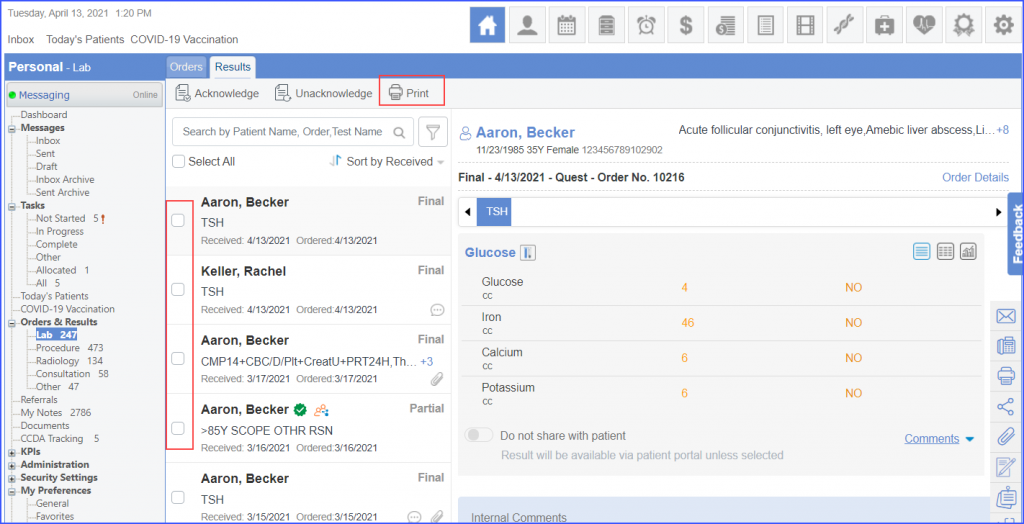
System prints multiple lab results.
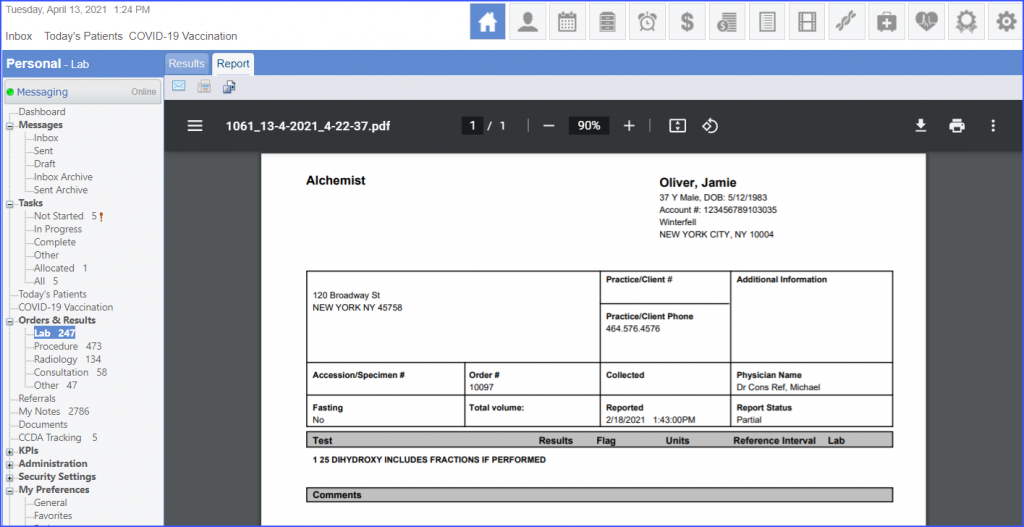
Users can only print multiple lab results which have the same requisition template configured. Click here, to view how to configure requisition template.
If the user attempts to print multiple lab results which have different requisition templates configure, the system displays an error message.

Acknowledged and unacknowledged lab results can be easily viewed in separate tabs.
By default, the system displays unacknowledged lab results.
Click the ‘Acknowledged’ tab to view the acknowledged lab results. Acknowledged badge is not displayed next to the accepted lab results.
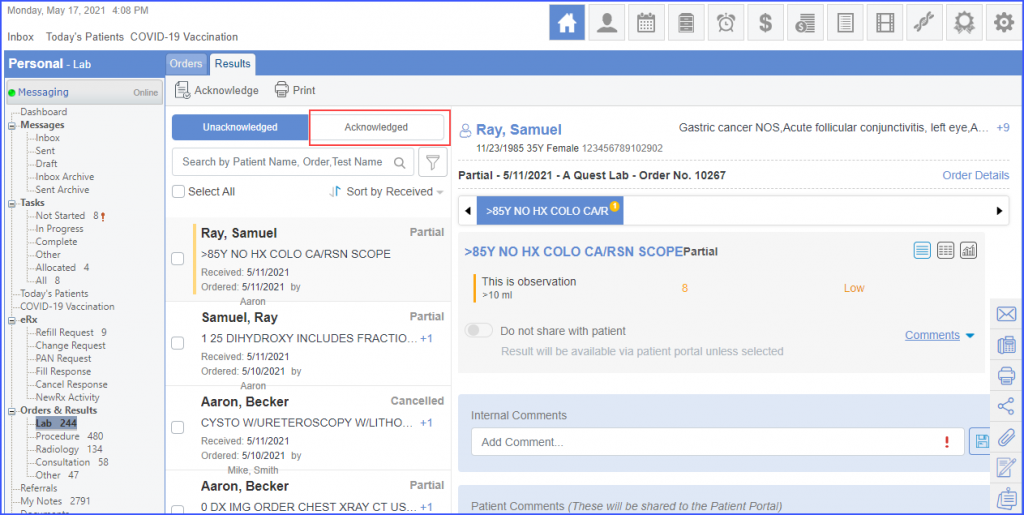
When the user is in the ‘Unacknowledged’ tab, the system displays the ‘Acknowledge’ button in the top action bar.
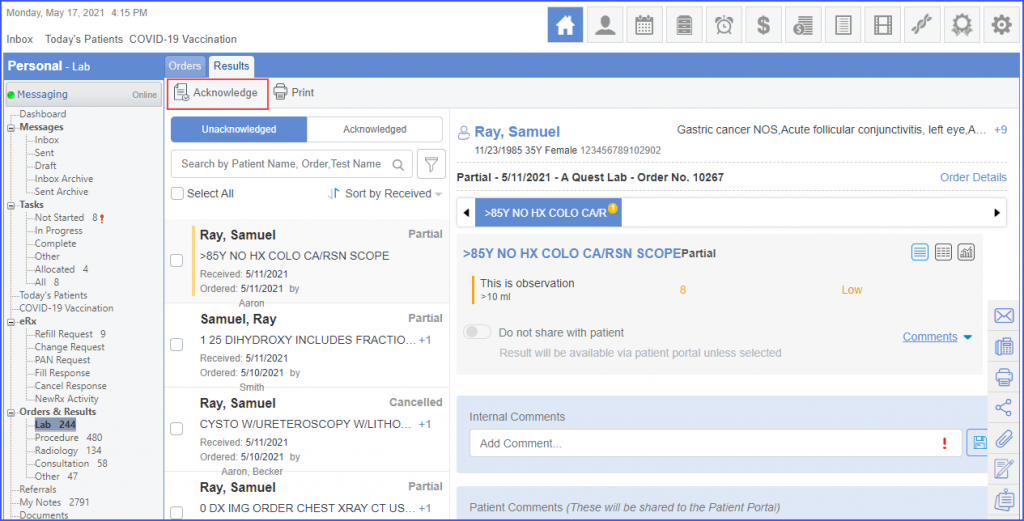
Similarly, when the user is in the ‘Acknowledged’ tab, the system displays the ‘Unacknowledge’ button in the top action bar.
Users can provide feedback about their experience of ‘Lab’ section.
This helps CureMD improve lab’s user experience.
To provide feedback, click on the ‘Feedback’ button.

Once the ‘Feedback’ button is clicked, a feedback overlay is displayed. Users can rate their experience by clicking on the desired star.

After a star is clicked, further feedback options appear. Click ‘Submit’ to submit the feedback.

Similar enhancement has been made in the ‘Clinical’ section. Click here, to view the change.
Patient comments can be printed on lab results with report template ‘LabCorp’, ‘LabCorp_LocID’, ‘SunRise’, ‘Quest’ or ‘BioReference’.
This helps users in viewing the complete information on the printed report.
In order to see how to select a lab report template, click here.
The users should also have enabled preference for adding patient comments on the lab report. To enable this preference, click here.
Select a lab result with patient comments added to it. Then click ‘Print’.
The system displays the patient comments on the printed lab result report.
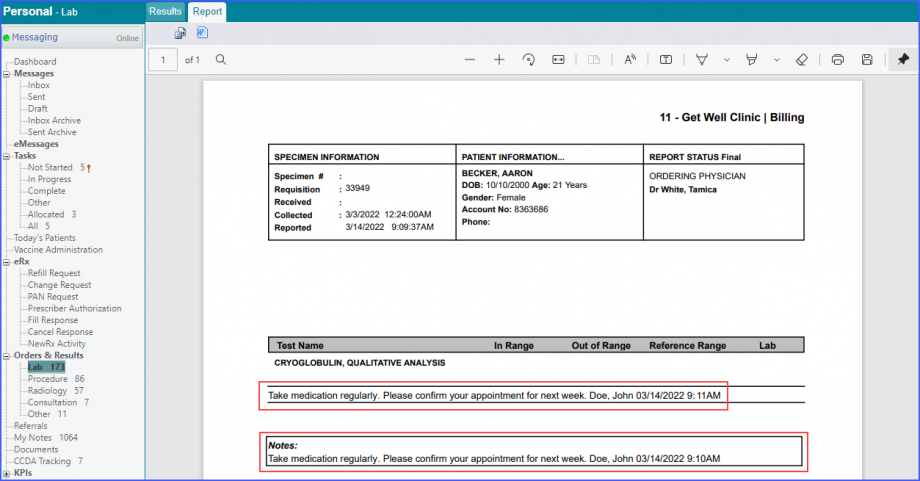
Smart phrases have been incorporated in the lab results beta view.
This allows providers to efficiently write notes/comments by using pre-defined phrases.
To view smart phrases, type (.A) in the ‘Internal Comments’ or ‘Patient Comments’ section and press Ctrl + Space.
The system displays a dropdown with top 5 results stored in alphabetical order.

The beta view of lab results is enabled by default for all newly created users.
Users can experience the enhanced interface of lab results from the beginning.
Users can disable the Beta View from the patient’s general preferences.
Disabling the Beta View would keep the old layout for the lab result page.
Click Here to learn how to disable the Beta View.
